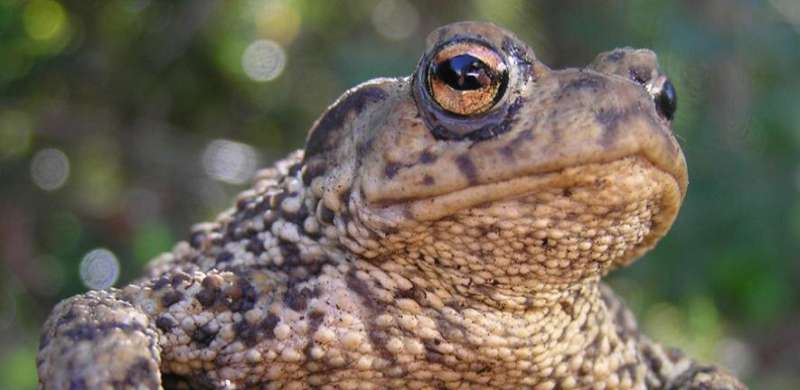Credit: Froglife
Volunteers investigating dormice and bats in trees made the unexpected discovery of more than 50 common toads in nest boxes and tree cavities at least 1.5 meters high
Until now, common toads were thought to be terrestrial. The tallest toad in this study was found ten feet high in a tree — and scientists say there’s a chance the toads could venture even higher.
It is the first time that the tree-climbing potential of amphibians has been investigated on a national scale.
The surprising discovery was made during a study of dormice and bats as part of the National Dormouse Monitoring Program and the Bat Tree Habitat Key project.
The research was led by the University of Cambridge and Froglife. It was published today in the magazine PLOS ONE†
dr. Silviu Petrovan, Senior Researcher at the University of Cambridge and Trustee at Froglife, and lead author of the study, said: “This is a very exciting finding and important to our understanding of the ecology and conservation of common toads – one of the most widespread and abundant European amphibians.”
“We know that common toads prefer forests as foraging and wintering habitats, but it seems that their association with trees is much more complex than we previously thought.”
Common toads are considered typical terrestrial amphibians, which spend their time both on land and in the water when breeding. To date, there are only a handful of documented sightings of common toads in trees in the UK.
As a result, no studies have ever been conducted on common toads and British amphibians in trees, unlike studies on bats and dormice, which specifically focus on this habitat. The study highlights the importance of sharing data between conservation organizations representing different species, and shows that there is much to learn about wildlife in the UK, even those that are believed to be known.
Nida Al-Fulaij, Conservation Research Manager at PTES said: “We couldn’t believe what we found. We are used to discovering forest birds and other small mammals in nest boxes, but we would not have thought of finding amphibians in them.”
More than 50 common toads were found during surveys of dormouse nest boxes (1.5 m above the ground) and tree hollows commonly used by bats.
Many of the cavities were small or not visible from the ground, so it’s unclear how toads find them and how difficult it is for toads to climb certain trees.
Toads were not found in boxes or tree hollows with other species, but they were found using old nests made by dormice and even birds.
While 50 records is not a huge number, it is comparable to records of other animals known to use trees regularly, such as blue tits. This suggests that toads spend more time in trees than previously thought. If true, it means common toads can be found in up to one in a hundred trees in the UK in particularly favorable areas, such as near large ponds or lakes.
The discovery suggests that tree hollows may be an even more important ecological feature than conservationists previously thought. It highlights the importance of protecting our remaining natural forest habitats, especially old trees with veteran features (such as hollows, fissures, and other natural cavities) for all wildlife.
Froglife research in 2016 showed that common toads in the UK have declined by an average of 68% over the past 30 years.
It is currently unknown why toads climb trees and use nest boxes. Factors may include foraging for food, avoiding predators, or avoiding parasites such as toad flies.
“Future focused research will allow scientists to better understand the reasons for this tree-climbing behavior in toads, and how forest management should take this into account,” Petrovan said.
Taiwan rushes to contain sudden cane toad invasion
Silviu O. Petrovan et al, Why link different citizen science surveys? Widespread arboreal habits of a terrestrial amphibian revealed by mammal research in Britain, PLOS ONE (2022). DOI: 10.1371/journal.pone.0265156
Froglife is calling on members of the public to report any sightings they have of amphibians in trees Dragon Finder Appor to contact them directly†
Quote: Toads surprise scientists by climbing trees in UK woodlands (2022, July 6), retrieved 6 July 2022 from https://phys.org/news/2022-07-toads-scientists-climbing-trees-uk.html
This document is copyrighted. Other than fair dealing for personal study or research, nothing may be reproduced without written permission. The content is provided for informational purposes only.

